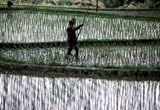Because of a lapse in government funding, the information on this website may not be up to date, transactions submitted via the website may not be processed, and the agency may not be able to respond to inquiries until appropriations are enacted. The NIH Clinical Center (the research hospital of NIH) is open. For more details about its operating status, please visit
cc.nih.gov. Updates regarding government operating status and resumption of normal operations can be found at
opm.gov.
Rice Cropping Intensity and Duck Populations Identified as Risk Factors for Bird Flu Outbreaks
March - April, 2008 | Volume 7, Issue 2

Intensive rice-cropping areas in
Southeast Asia may be a key risk
factor in the persistence of H5N1
(Photo: UN/S. Rotner)
The intensity of rice cropping and size of free-grazing duck populations have been identified as risk factors for bird flu outbreaks in Thailand and may apply elsewhere, according to a Fogarty-supported study.
Scientists used a combination of new data sets to track the risk patterns of the highly pathogenic H5N1 avian influenza in Southeast Asia. Because results of prior studies suggest the region may act as an "evolutionary sink" for the H5N1 virus, the research team focused on domestic ducks in intensive rice-cropping areas as a risk factor in Thailand and Vietnam, two countries that have experienced recurring outbreaks of the virus.
The paper, which was published in the Proceedings of the National Academy of Sciences, examined the statistical relationships between the recorded H5N1 virus presence and a set of five key environmental variables including elevation, human population, chicken numbers, duck numbers and rice cropping intensity, for three simultaneous epidemics in Thailand and Vietnam. According to the study, rice paddy fields are an important habitat for free-ranging ducks, but also for wild waterfowl exploiting the same food resource in the wintering season, and may form a critical risk factor in the introduction, persistence and spread of H5N1.
Remote sensing data provided by NASA played a key role in the study. Using imagery gathered from sensors on NASA's TERRA satellite, the researchers were able to map rice paddy agriculture in the region. The resulting algorithms allowed them to monitor cropping intensity, planting and harvesting dates, and irrigation practices at moderate resolution and in near real-time.
The authors conclude that the five variables can act as reliable predictors for mapping risk patterns of H5N1. Free-grazing ducks were found in much higher numbers where rice-cropping is intense, while farmed ducks were not found to be significantly associated with virus presence. The paper also suggests this model may apply in other countries with similar agricultural and ecological conditions, such as Laos or Cambodia.
In Southeast Asia alone, it was estimated that H5N1 virus outbreaks caused the death of 140 million domestic birds with economic losses at around $10 billion, according to the WHO. Additionally, there is concern that the continued spread of the virus across eastern Asia represents a serious threat if the virus mutates into a version that is transmitted easily from poultry to humans. Since 2003, the number of reported human H5N1 cases in Asia, Europe, and Africa has risen to over 300, with about half of those infected dying.
To learn more, visit: http://www.pnas.org/cgi/conent/full/105/12/4769
Mapping H5N1 highly pathogenic avian influenza risk in Southeast Asia. Marius Gilbert, Xiangming Xiao, Dirk U. Pfeiffer, M. Epprecht, Stephen Boles, Christina Czarnecki, Prasit Chaitaweesub, Wantanee Kalpravidh, Phan Q. Minh, M.J. Otte, Vincent Martin, and Jan Slingenbergh PNAS. 2008; 105:4769-4774.
To view Adobe PDF files,
download current, free accessible plug-ins from Adobe's website.
Related World Regions / Countries